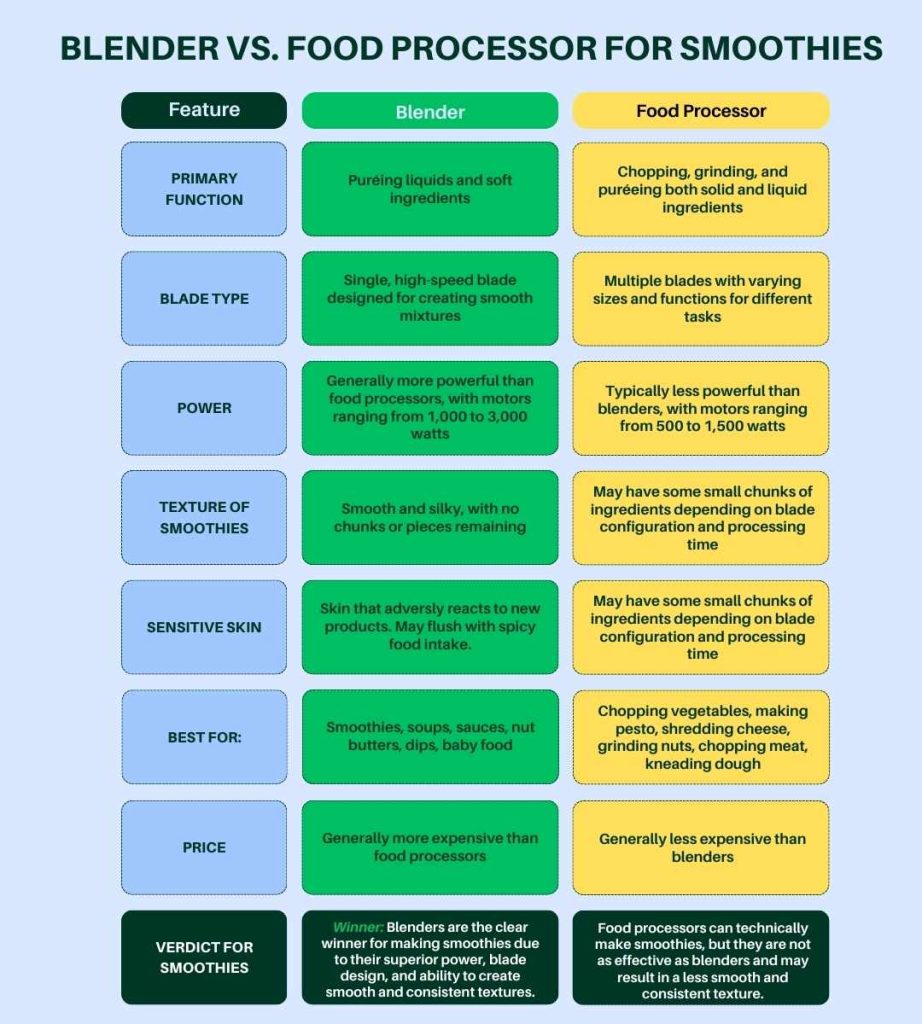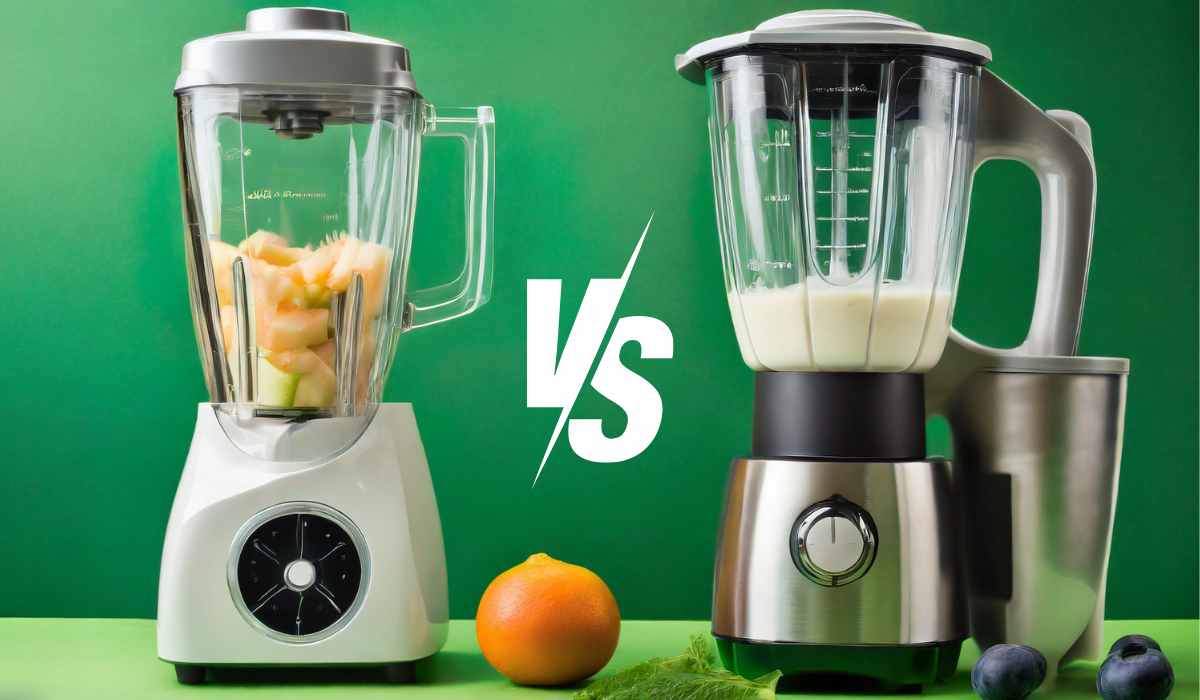In my depth research, it can be said that there is an epic battle between two renowned cooking giants—the blender and the food processor—was about to happen in a busy kitchen. There was a lot of excitement in the air as fruits, veggies, and other elements watched this battle, eager to see what would happen to them in the quest for the perfect smoothies.
The sleek and robust machine blender gave off a confident vibe. Its blades sparkled with the promise of blending tastes and textures smoothly, turning ingredients into a silky syrup of joy. As it got ready to show off its skills at quickly and smoothly mixing, it hummed with excitement.
In my analysis, I will go over or experiment different comparisons, tips and tricks, its working process for Smoothies. So lets find out the basic differences between “Blender vs Food Processor” and related factors for smoothies.
Blender Vs. Food Processor – A Battle What You Need To Know
An epic battle between two renowned cooking giants—the blender and the food processor—was about to happen in a busy kitchen. There was a lot of excitement in the air as fruits, veggies, and other elements watched this battle, eager to see what would happen to them in the quest for the perfect drink.
The sleek and robust machine blender gave off a confident vibe. Its blades sparkled with the promise of blending tastes and textures smoothly, turning ingredients into a silky syrup of joy. As it got ready to show off its skills at quickly and smoothly mixing, it hummed with excitement.
The food processor, a flexible machine with many tools and blades, was on the other end of the
bar. It said that it could cut, dice, and mix things very precisely. Food processor offers a blended drink with more textures and flavors than any other smoothie maker.
The blender’s strong motor roared to life as soon as the fight started, spinning inside it like a tornado. The fruits and vegetables spun around effortlessly, giving in to the power of their blades. They quickly turned into a homogeneous mix of bright colors and flavors.
Follow more discussion:
On the other hand, the food processor started its unique journey. It carefully changed the ingredients by buzzing and chopping them, creating a patchwork of textures that danced in a smooth rhythm, offering a multi-layered experience with every sip.
The food processor, a flexible machine with many tools and blades, was on the other end of the bar. It said it could cut, dice, and mix things precisely, offering a blended drink with more textures and flavors than any other smoothie maker.
The blender’s strong motor roared to life when the fight started, spinning inside it like a tornado. The fruits and vegetables spun around effortlessly, giving in to the power of their bellies. They quickly turned into a homogeneous mix of bright colors and flavors.
On the other hand, the food processor started its unique journey. It carefully changed the ingredients by buzzing and chopping them, creating a patchwork of textures that danced in a smooth rhythm, offering a multi-layered experience with every sip.
It was a festival of sights and sounds in the kitchen, with people mixing and preparing food. Each machine worked hard and showed off its unique skills in the race to make the best drink.
The final mixtures came together amidst the sound of motors whirring and the delicious smell of fresh fruit. The blender made a lusciously smooth potion, and the food processor made a textured beauty with a wide range of tastes ready to enjoy.
The blender and the food processor worked their magic in this cooking story, each showing a different way to make the perfect smoothie. The room was quiet as the taste began, and the decision was waiting in the smiles and happy sighs after each sip.
Even though the fight was over, the memory of this culinary showdown lived on as a testament to the skill and versatility of both tools in the never-ending quest for the perfect smoothie.
How Food Processors Work – Need to Know
If you want to quickly chop, slice, cut, grind, or prepare almost any food, a food processor is the tool for you. Its functionality is achieved through powerful motors, rotating blades, and interchangeable discs.
Here’s a breakdown of how it works:
Components Needed:
- Base: This part holds the motor that turns the blade shaft.
- Bowl: A bowl that can be taken off and used to make food.
- Lid: During cooking, the lid keeps the food inside the bowl and seals it.
- Feed tube: A hole in the lid lets you add items while the meat is cooking.
- Blade shaft: This part turns quickly to power the blades.
- Blades: are replaceable and come in various sizes and forms for different uses.
- Discs: “Discs” are replaceable discs with multiple hole sizes for various cutting and chopping jobs.
Functions Important:
- Force: When put in and turned on, the motor turns the blade shaft.
- Adding ingredients: They can go through the feed tube or right into the bowl.
- Processing: Using the right blade or disc, the spinning blades can chop, slice, cut, or grind the food.
- Limits on speed: Most food processors have more than one speed setting, which lets you change how hard the cooking is.
- Pulse function: This lets you process things quickly, which is great for delicate items or getting the shape you want.
- Lock on the lid: The lid locks firmly onto the bowl, keeping it safe to use and stopping spills.
- Parts that can be taken off: For easy cleaning, the bowl, lid, blade shaft, and blades can all be taken off.
Types of blades and discs:
- S-blade: This is an S-blade, which can chop, grind, and blend.
- Dough blade: Kneads dough for pizza, bread, and other baked goods with the dough blade.
- Shredding discs: Cut up cheese, fruits, and veggies into different sizes.
- Slicing discs: Using slicing tools, cut fruits, veggies, and meats into even slices.
- Dicing disc: Foods are cut into regular pieces with a dicing tool.
Things to remember:
- Always make sure you use the right blade or disc for the job.
- Put only a little in the bowl, which can slow down the process.
- Use the pulse mode for fragile items and to get the thickness you want.
- After each use, clean the food processor very well.
The food processor is an essential tool in many homes because it can do many things and is easy to use. If you know how it works, you can get the most out of it and use it for various cooking jobs.
What Works Best In A Food Processor For Smoothies?
Technically, you can make smoothies with any food processor, but some features and functions are better than others for getting the best mix.
This is the best thing to put in a food processor to make smoothies:
Strong motor: For entirely crushing ice and frozen veggies, common ingredients in smoothies, you need a strong motor. Find an engine that has at least 1000 watts of power.
Cutting very sharp edges: The blades are what make your drink smooth. Pick stainless steel blades that are sharp and made to crush and mix.
Large bowl: A bowl with a large volume lets you make more smoothies and fit more types of materials. Find a bowl that can hold at least 4 cups.
Pulse function: The pulse function lets you finetune the mixing process. This is especially useful for cutting things up very small and getting the right balance.
Stick: A tamper helps move thicker ingredients closer to the blades so that the mixture is fully mixed and there are no chunks.
Some extra features are:
Multiple speed settings: You can change how hard the blender works to mix different items and get the desired smoothie taste.
Ice-crushing feature: It can break the ice, which is excellent for people who like cold and icy drinks.
Self-cleaning function: The ability to clean itself saves time and effort.
How Blenders Work – Its Important
Blenders are small tools on your table that use fast blades to cut, grind, and mix food. You can make drinks, soups, stews, dips, and more with them.
In short, here’s how they work:
Components Needed:
- Base: This part holds the motor that turns the blade assembly.
- Jar: Usually made of glass or plastic, the jar holds the ingredients.
- Lid: During preparation, the lid keeps the food inside the jar and seals it.
- Blade assembly: This part has sharp blades that spin very quickly.
- Controls: The blender has buttons or knobs that let you turn it on and off, change the speed, and use any other features.
Functions Work:
- Power: Turning on the motor and plugging it in starts spinning the blade assembly.
- Food placement: Put the food in the jar after adding the ingredients and making sure the lid is tight.
- Blending: When you blend, the blades that are turning chop and grind the food into smaller and smaller bits.
- Vortex: The blades’ pitch and the shape of the jar make a vortex, which is a spinning action that pulls the ingredients toward the blades so they are evenly mixed.
- Controlling the speed: Most blenders have more than one speed setting, so you can change how strong the mixing is.
- Pulse function: This lets you mix for short periods of time, which is great for getting the look you want or to avoid over-processing.
- Lid lock: The lid locks firmly onto the jar, keeping it safe to use and stopping spills.
- Parts that can be taken off: The jar, lid, and blade system can all be taken off for easy washing.
What Works Best In A Blender For Smoothies ?
When picking out a blender for drinks, there are a few important things to attach keeping in mind.
This is what works best:
Strength of the motor: For easily crushing ice and frozen veggies, which are popular smoothie ingredients, you need a motor with a lot of strength. Choose a motor that has at least 1000 watts of power.
Sharp blades: If your blades are sharp, your smoothie will be silky smooth with no chunks. For ice breaking and mixing cold foods, look for tools made of stainless steel.
Size of the jar: Think about how often and how many smoothies you want to make. A 16-ounce jar might be enough for one serve. A 48-ounce jar or bigger is best if you often make bigger batches.
Material of the container: Glass jars are heavier but last longer and don’t hold on to flavors or smells. Although plastic jars are cheaper and lighter, they can scratch or break over time and soak up smells and tastes.
Speed settings: You can change the way the mixing works by changing the speed settings. A higher speed setting is best for breaking up ice and frozen veggies, while a lower speed setting is best for mixing soft ingredients and making a thick paste.
Pulse function: You can finetune the mixing process with the pulse tool. It helps add more ingredients after the first mix and keeps the smoothie from being over-processed, which can heat it up and make it mushy.
Stick: A tamper helps move thicker ingredients closer to the blades so that the mixture is fully mixed and there are no chunks. This helps a lot with smoothie bowls that are thicker or have nut butters.
Some extra features are:
Setting already set: Some blenders have smoothie settings, making it easier to get the thickness you want without having to guess.
Ice crushing feature: The ice breaking feature is great for people who like their drinks cold and icy.
Self-cleaning function: The ability to clean itself saves time and effort.
Personal blender cups: Personal blender cups are great for making smoothies for one person and are easy to carry around.
Blender vs Food Processor for Smoothies: A comparison Table

Here’s follow the table for Basic Differences.
Food Processor vs. Blender: Substitutions and Limitations
Food processors and blenders are helpful kitchen tools, but they’re best at doing certain things.
Here is a list of what they can and can’t do as substitutes for each other:
Karmas, Etal. (2012) titled on “Nutritional evaluation of food processing” and suggested that nutrients are mostly lost when foods are processed because they are easily damaged by air, light, heat, or the pH of the liquid. These effects might be sped up by enzymes and trace elements, especially copper and ron. So, be careful, when processing food on food processor.
Food Processor as a Blender Substitute:
Yes, sometimes a food processor can be used instead of a mixer. You can chop, grind, and blend fruits and veggies for drinks, but it has some limits:
Texture: Food makers sometimes make the texture smoother than blenders do. This is because their blades aren’t made to create the same swirling effect that pulls ingredients toward the blades so that they can be mixed well.
Crushing ice: Food makers often need help breaking up ice properly, which makes shakes chunky.
Processing time: Blenders have more power and different blade designs, so they usually blend items faster than food processors.
Cleaning: Some food processors have blades that are hard to take off and clean, which makes them less useful than blenders.
Tips for using a food processor as a blender:
- You can make smoothies with the S-blade.
- Adding liquids little by little will help you get the right consistency.
- If you want more control over the thickness, pulse the food processor instead of running it all the time.
- For better results, use fruits and veggies that have already been chopped.
- So as not to damage the blade, add the ice after the other materials have been mixed.
Blender as a Food Processor Substitute:
Blenders aren’t the best thing to use instead of food processors. They can chop and blend some foods, but they can’t do everything:
Slicing and chopping: Blenders aren’t made to cut and chop items evenly. They might make the pieces uneven or make the features mushy.
Grind: Blenders aren’t strong enough to properly grind nuts, grains, or spices.
Making the dough: Blenders can’t do the hard work of making dough.
Tips for using a blender as a food processor:
- To chop things, use the pulse feature.
- Do it in small amounts so the blender doesn’t get too full.
- Putting in liquids will help you chop.
- If you don’t want to grind the spices yourself, buy them already ground.
In summary:
- Smoothies can be made with food processors instead of blenders, but they don’t work as well for cleaning, crushing ice, or changing the taste of the smoothie.
- Because they aren’t powerful enough or designed well enough to chop, slice, grind, or make dough, blenders aren’t good alternatives to food processors.
Which Is More Expensive: A Food Processor Or A Blender?
Most of the time, food processors cost more than blenders. But the exact price range for each device varies on a number of things, such as:
Food Processors:
- Features: High-end food makers with lots of extra parts, big bowls, and strong fans can cost more than $500. For about $100, you might be able to find smaller, simpler units with fewer features.
- Brand: Well-known and popular brands like Cuisinart, KitchenAid, and Breville tend to cost more than less well-known names.
- Materials: Durable materials, like stainless steel, will make food makers cost more than plastic ones.
Blenders:
- Features: Powerful blenders with pre-set settings, self-cleaning features, and personal blender cups can cost between $200 and $400. For about $50, you can find simple blenders with fewer features and motors with less power.
- Brand: Like food processors, blenders from well-known brands like Ninja, Vitamix, and Blendtec tend to cost more than blenders from less well-known names.
- Materials: Jars made of glass tend to be more expensive than plastic ones, but they last longer and don’t catch tastes or smells as easily.
Here’s a general comparison:
| Budget food processor: $100 – $200 Mid-range food processor: $200 – $400 High-end food processor: $400+ | Budget blender: $50 – $100 Mid-range blender: $100 – $200 High-end blender: $200+ |
Ultimately, the price difference between a blender and a food processor varies on which type you look at. When deciding what to buy, you should consider your wants and funds.
What Is The Best For Smoothies – Food Processor Or Blender?
Which blender is best for making smoothies depends on your needs and the kind of drinks you like.
To sum up:
- A blender is the best way to get the smoothest texture and the ability to crush ice.
- A food processor might be better if you need to make a lot of food at once or do a lot of different things in the kitchen.
Final Say
In my research, it is recommended that the following factors to be considered before going decision:
- Your budget: Food processors are generally more expensive than blenders.
- The type of smoothies you make: A food processor might be more suitable if you prefer thick, chunky smoothies.
- Storage space: Blenders are typically smaller and easier to store than food processors.
Ultimately, the best way to decide is to try both appliances and see which one you prefer. You might even find that having a food processor and a blender in your kitchen allows you to expand your culinary repertoire and enjoy a wider variety of delicious dishes.
References:
Karmas, E., & Harris, R. S. (2012). Nutritional evaluation of food processing. Springer Science & Business Media.

Tammy E. Edison is a distinguished specialist in the world of kitchen appliances, and she is proud to be a part of the dynamic team at kitchenusers.com. With a background in engineering and a passion for culinary innovation, Tammy E. Edison has established herself as a go-to expert for all things related to kitchen appliances technology.


